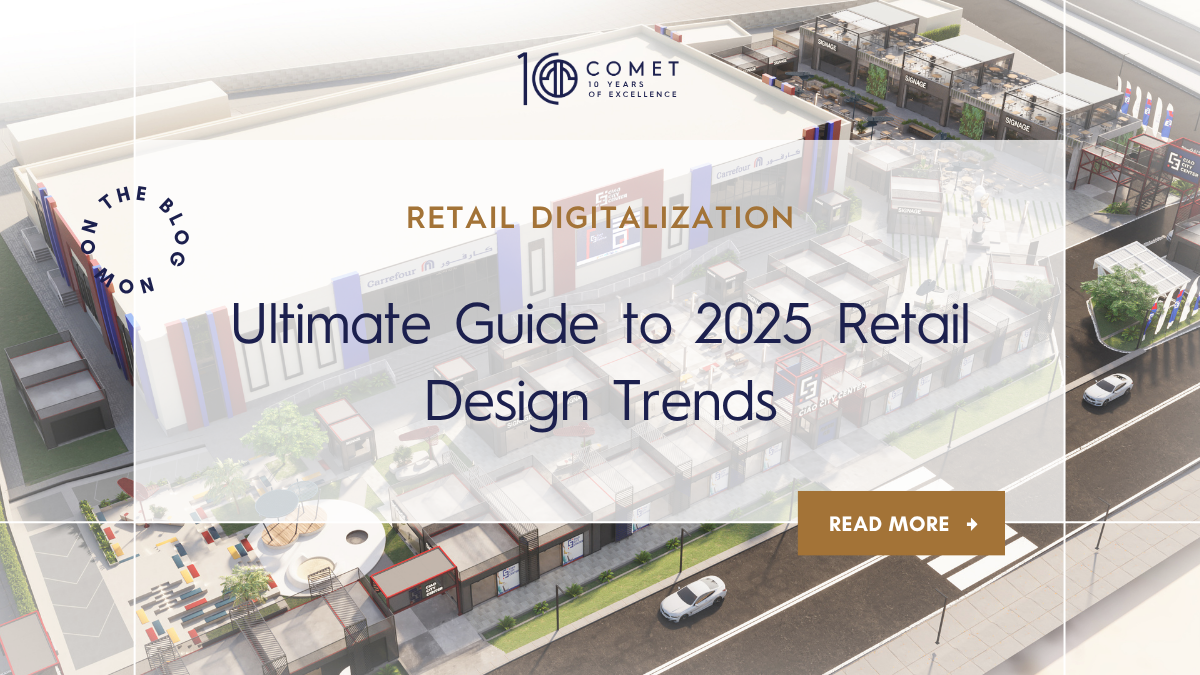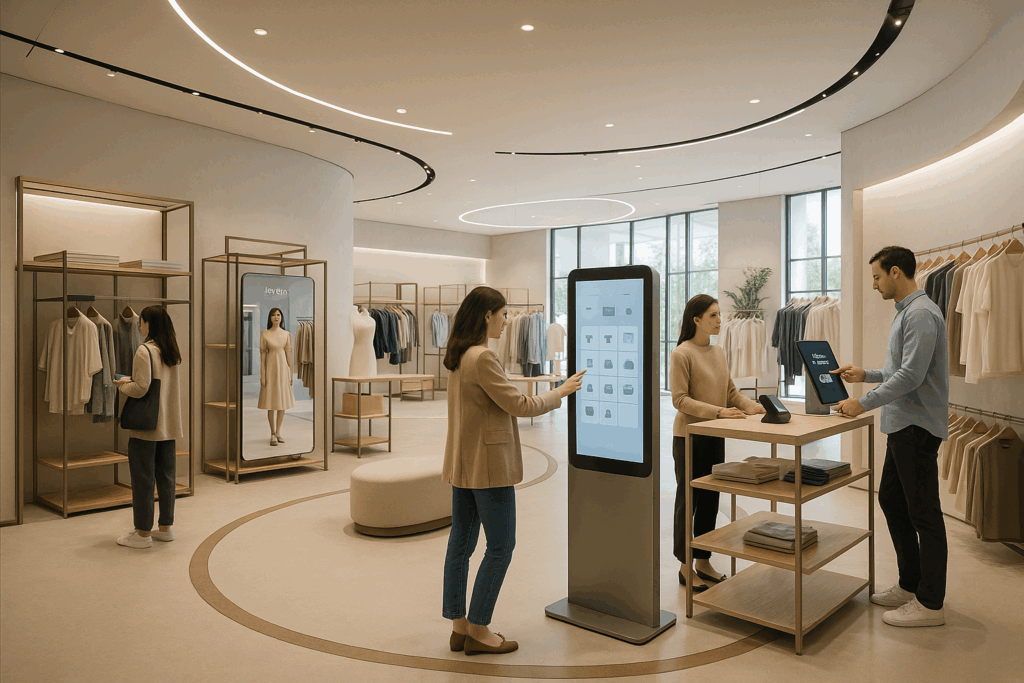
Ultimate Guide to 2025 Retail Design Trends: Revolutionary Strategies for Modern Stores
Retail design trends 2025 are revolutionizing how brands connect with customers, creating immersive experiences that blend physical and digital elements seamlessly. As we navigate the evolving retail landscape, three groundbreaking trends are reshaping store environments: flexible pop-ups, strategic digital touchpoints, and innovative circular layouts.
The retail industry continues to transform at an unprecedented pace, with consumer expectations driving the need for more dynamic, adaptable, and technologically integrated shopping experiences. Understanding these retail design trends 2025 is crucial for retailers looking to stay competitive and create memorable brand interactions.
The Evolution of Retail Design in 2025

Why Retail Design Trends 2025 Matter More Than Ever
The pandemic fundamentally shifted consumer behavior, accelerating the demand for flexible, health-conscious, and digitally enhanced retail environments. Today’s shoppers expect seamless omnichannel experiences that adapt to their individual preferences and needs.
Modern retail design goes beyond aesthetics—it’s about creating functional spaces that drive sales, enhance brand loyalty, and provide measurable ROI. The retail design trends 2025 we’re seeing reflect this shift toward purposeful, data-driven design decisions.
Trend #1: Flexible Pop-Up Retail Spaces
Redefining Temporary Retail Experiences
Flexible pop-ups represent one of the most significant retail design trends 2025, offering brands unprecedented agility in reaching customers. These adaptable spaces can transform from product showcases to experiential workshops within hours, maximizing utility and minimizing overhead costs.
Key Features of Modern Pop-Up Design:
- Modular Display Systems: Easily reconfigurable fixtures that adapt to different product categories and brand requirements
- Portable Technology Integration: Wireless payment systems, mobile POS terminals, and battery-powered digital displays
- Multi-Purpose Furniture: Seating that doubles as storage, tables that convert to display platforms
- Rapid Setup Solutions: Pre-fabricated components that enable same-day store transformations
Benefits for Retailers
The flexibility inherent in these retail design trends 2025 allows brands to test new markets, launch products, and create buzz without long-term real estate commitments. Successful pop-up campaigns have shown up to 80% higher engagement rates compared to traditional retail formats.
Implementation Strategies
Retailers implementing flexible pop-ups should focus on creating brand-consistent experiences while maintaining operational efficiency. This includes developing standardized setup procedures, training mobile teams, and investing in portable technology solutions.
Trend #2: Strategic Digital Touchpoints Integration
Seamless Physical-Digital Convergence
Digital touchpoints are becoming integral to retail design trends 2025, creating connected experiences that bridge online and offline customer journeys. These technologies enhance product discovery, streamline checkout processes, and provide valuable customer insights.
Essential Digital Touchpoints:
- Interactive Product Displays: Touchscreen kiosks providing detailed product information, reviews, and comparison tools
- Smart Mirrors: AR-enabled mirrors for virtual try-ons and style recommendations
- Mobile App Integration: QR codes linking to exclusive content, loyalty programs, and personalized offers
- Voice-Activated Assistants: Hands-free customer service and product information systems
- Digital Wayfinding: Interactive store maps and navigation assistance
Enhancing Customer Experience
Strategic placement of digital touchpoints can increase dwell time by up to 45% while providing retailers with real-time analytics on customer preferences and behavior patterns. These insights inform inventory decisions, marketing strategies, and future store layouts.
Technology Considerations
When implementing digital touchpoints as part of retail design trends 2025, retailers must consider factors such as network reliability, security protocols, and maintenance requirements. Cloud-based solutions offer scalability and remote management capabilities essential for multi-location retailers.
Trend #3: Circular Store Layouts
Optimizing Traffic Flow and Customer Journey
Circular layouts represent a fundamental shift in how retailers approach space planning, moving away from traditional linear pathways toward more intuitive, discovery-focused designs. This trend in retail design trends 2025 encourages natural browsing patterns while maximizing product exposure.
Advantages of Circular Design:
- Improved Traffic Distribution: Eliminates bottlenecks and creates multiple pathway options
- Enhanced Product Visibility: Central focal points draw attention to featured merchandise
- Natural Shopping Flow: Mimics human tendency to explore in circular patterns
- Flexible Zoning: Easy reconfiguration for seasonal changes and promotions
- Social Shopping Integration: Creates gathering spaces that encourage group browsing
Design Implementation
Successful circular layouts require careful consideration of sight lines, product hierarchies, and customer behavior patterns. Key elements include strategically placed anchor points, varied display heights, and clear wayfinding systems.
Research indicates that circular store layouts can increase average purchase values by 25-30% compared to traditional grid systems, making this one of the most impactful retail design trends 2025 for driving revenue growth.
Integration Strategies for Maximum Impact
Combining Multiple Trends
The most successful retail environments integrate all three retail design trends 2025, creating cohesive experiences that leverage the strengths of each approach. This might involve circular layouts with strategically placed digital touchpoints and modular elements that support pop-up activations.
Measuring Success
Retailers should establish clear KPIs for evaluating the effectiveness of new design implementations:
- Sales per square foot improvements
- Customer dwell time increases
- Conversion rate optimization
- Digital engagement metrics
- Customer satisfaction scores
Technology Requirements and Considerations
Infrastructure Needs
Implementing retail design trends 2025 requires robust technological infrastructure including high-speed internet, adequate power distribution, and flexible networking solutions. Cloud-based systems provide the scalability and reliability needed for dynamic retail environments.
Security and Privacy
As digital integration increases, retailers must prioritize cybersecurity and customer data protection. This includes secure payment processing, encrypted customer data, and compliance with privacy regulations.
Sustainability and Future-Proofing
Eco-Conscious Design Choices
Modern retail design trends 2025 emphasize sustainability through modular components, energy-efficient technologies, and materials with minimal environmental impact. Retailers are increasingly choosing designs that support circular economy principles.
Adaptability for Future Changes
The rapid pace of technological advancement requires retail designs that can evolve with emerging trends. Future-proofing strategies include flexible infrastructure, upgradeable technology platforms, and modular design elements.
Case Studies and Success Stories
Leading Brands Setting Examples
Several major retailers have successfully implemented these retail design trends 2025, reporting significant improvements in customer engagement and sales performance. Nike’s House of Innovation stores exemplify the integration of digital touchpoints with flexible layouts, while Nordstrom’s pop-up strategy demonstrates the power of adaptable retail spaces.
Lessons Learned
Successful implementations share common characteristics: strong leadership commitment, adequate technology investment, and comprehensive staff training programs. Retailers that treat these trends as holistic strategies rather than isolated initiatives achieve the best results.
Implementation Timeline and Budget Considerations
Phased Approach Recommendations
Retailers should consider implementing retail design trends 2025 through a phased approach:
- Phase 1: Digital touchpoint integration and staff training
- Phase 2: Layout optimization and circular design elements
- Phase 3: Flexible pop-up capabilities and advanced analytics
Cost-Benefit Analysis
While initial investments can be substantial, the ROI from successful implementation of retail design trends 2025 typically becomes apparent within 6-12 months through increased sales, improved operational efficiency, and enhanced customer loyalty.
Staff Training and Change Management
Preparing Teams for New Environments
Successful implementation requires comprehensive training programs that help staff understand and leverage new technologies and layouts. This includes customer service training for digital touchpoints and operational procedures for flexible spaces.
Ongoing Support Systems
Retailers should establish ongoing support systems including regular training updates, performance monitoring, and feedback collection to ensure continued success with retail design trends 2025.
Frequently Asked Questions (FAQs)
What are the most important retail design trends 2025?
The three most significant retail design trends 2025 are flexible pop-up spaces, strategic digital touchpoint integration, and circular store layouts. These trends focus on creating adaptable, technology-enhanced environments that improve customer experience and operational efficiency.
How much does it cost to implement retail design trends 2025?
Implementation costs vary significantly based on store size and complexity. Basic digital touchpoint integration might cost $10,000-50,000 per location, while comprehensive redesigns including circular layouts and flexible systems can range from $100,000-500,000 per store.
What ROI can retailers expect from these design trends?
Retailers typically see ROI within 6-12 months through increased sales per square foot (15-30% improvement), higher conversion rates (10-25% increase), and improved customer satisfaction scores. The specific returns depend on implementation quality and market conditions.
Are retail design trends 2025 suitable for small businesses?
Yes, many aspects of retail design trends 2025 can be scaled for smaller businesses. Digital touchpoints like QR code integration and basic modular displays offer cost-effective entry points, while circular layout principles can be applied regardless of store size.
How do these trends affect customer privacy?
Digital touchpoints in retail design trends 2025 do collect customer data, but retailers must comply with privacy regulations like GDPR and CCPA. Best practices include transparent data collection policies, secure storage systems, and giving customers control over their information.
What technologies are essential for implementing these trends?
Key technologies include high-speed internet, cloud-based POS systems, interactive displays, mobile payment solutions, and customer analytics platforms. The specific requirements depend on which retail design trends 2025 you prioritize.
How long does it take to see results from new retail design implementations?
Most retailers begin seeing measurable improvements within 30-60 days of implementing retail design trends 2025. Full impact typically becomes apparent after 3-6 months as customers adapt to new experiences and staff become proficient with new systems.
Can these trends work for online-only retailers expanding to physical stores?
Absolutely. Retail design trends 2025 are particularly beneficial for digital-native brands entering physical retail, as they provide natural integration points between online and offline experiences, helping maintain brand consistency across channels.
Ready to Transform Your Retail Space?
The retail landscape is evolving rapidly, and staying ahead of retail design trends 2025 is essential for maintaining competitive advantage. Whether you’re planning a complete store redesign or looking to incorporate specific elements like digital touchpoints or flexible layouts, the time to act is now.
Follow us on social media for the latest updates on retail design trends:
Visit our website for comprehensive resources, case studies, and expert consultation on implementing retail design trends 2025 in your business. Our team of experienced designers and technology specialists can help you create retail environments that drive results and exceed customer expectations.
Don’t let your competition get ahead—start planning your retail transformation today!
